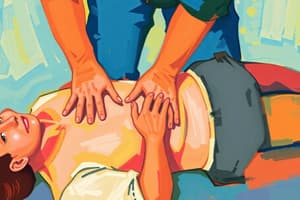Podcast
Questions and Answers
What is the primary purpose of administering chest compressions during CPR?
What is the primary purpose of administering chest compressions during CPR?
- Restore spontaneous breathing (correct)
- Clear airway obstruction
- Stimulate neural responses in the heart
- Circulate blood to vital organs (correct)
What is the correct compression-to-ventilation ratio for pediatric CPR with two rescuers?
What is the correct compression-to-ventilation ratio for pediatric CPR with two rescuers?
- 20:2
- 15:2
- 10:2
- 30:2 (correct)
What is the appropriate first action when using an AED on an unresponsive patient?
What is the appropriate first action when using an AED on an unresponsive patient?
- Begin CPR immediately
- Turn on the AED (correct)
- Ensure the scene is safe before proceeding
- Check for vital signs
In a scenario with a suspected cervical spine injury, which maneuver should be used to open the airway?
In a scenario with a suspected cervical spine injury, which maneuver should be used to open the airway?
What is the recommended depth of chest compressions for adult CPR?
What is the recommended depth of chest compressions for adult CPR?
What is the correct compression-to-ventilation ratio for performing BLS on a child with a single rescuer?
What is the correct compression-to-ventilation ratio for performing BLS on a child with a single rescuer?
When performing CPR on an adult, how should the AED pads be positioned?
When performing CPR on an adult, how should the AED pads be positioned?
During BLS, which of the following accurately represents the ideal pause duration for chest compressions?
During BLS, which of the following accurately represents the ideal pause duration for chest compressions?
What phase in CPR is referred to as 'recoil'?
What phase in CPR is referred to as 'recoil'?
In the context of BLS, which statement regarding the 'chain of survival' is true?
In the context of BLS, which statement regarding the 'chain of survival' is true?
Flashcards
Adult CPR Compression Ratio
Adult CPR Compression Ratio
The ratio of chest compressions to breaths during adult Cardiopulmonary Resuscitation (CPR) with a single rescuer is 30:2.
Adult CPR Compression Depth
Adult CPR Compression Depth
Chest compressions should be performed to a depth of 2-2.4 inches in adults during CPR.
Adult CPR Compression Rate
Adult CPR Compression Rate
The recommended rate for chest compressions in adult CPR is 100-120 compressions per minute.
Adult CPR Hand Placement
Adult CPR Hand Placement
Place the hands over the lower half of the sternum (breastbone) for chest compressions in adults.
Signup and view all the flashcards
BLS Initial Assessment
BLS Initial Assessment
After confirming unresponsiveness, check for breathing and a pulse in Basic Life Support (BLS).
Signup and view all the flashcards
AED Use Criteria
AED Use Criteria
Use an Automated External Defibrillator (AED) if a person is unresponsive and not breathing normally.
Signup and view all the flashcards
AED Shock Procedure
AED Shock Procedure
If the AED advises a shock, ensure no one is touching the patient and deliver the shock.
Signup and view all the flashcards
Infant CPR Compression Depth
Infant CPR Compression Depth
During infant CPR, chest compressions should be 1.5 inches in depth.
Signup and view all the flashcards
Airway Opening Technique (No injury)
Airway Opening Technique (No injury)
Use Head-tilt and Chin-lift for opening the airway if no suspected cervical spine injury.
Signup and view all the flashcards
Airway Opening Technique (Suspected Spine)
Airway Opening Technique (Suspected Spine)
Use the Jaw-thrust maneuver if a suspected cervical spine injury exists to open the airway.
Signup and view all the flashcards
Two-rescuer CPR for adults
Two-rescuer CPR for adults
One rescuer provides chest compressions, while the other manages breaths.
Signup and view all the flashcards
CPR CAB
CPR CAB
During basic life support (BLS), CAB stands for Circulation, Airway, and Breathing.
Signup and view all the flashcards
Child CPR ratio
Child CPR ratio
In a single-rescuer child CPR, the ratio of compressions to breaths is 30:2.
Signup and view all the flashcards
AED adult placement
AED adult placement
For adults, place one AED pad on the upper-left chest and one on the lower-right.
Signup and view all the flashcards
CPR recoil phase
CPR recoil phase
The recoil phase in CPR is when the chest relaxes, allowing blood to refill the heart.
Signup and view all the flashcards
When to stop CPR
When to stop CPR
Stop CPR when the patient shows signs of life or advanced help arrives.
Signup and view all the flashcards
Infant pulse check
Infant pulse check
In BLS for infants, the femoral pulse is checked.
Signup and view all the flashcards
Child definition BLS
Child definition BLS
A child in BLS is someone between the ages of 1 and puberty.
Signup and view all the flashcards
Ventilation rate advanced airway
Ventilation rate advanced airway
With advanced airway in place, the ventilation rate for adults is 6-8 breaths per minute.
Signup and view all the flashcards
Foreign object airway obstruction
Foreign object airway obstruction
If an unresponsive patient has a blocked airway by a foreign object, perform back blows then chest thrusts.
Signup and view all the flashcards
BLS training refresh
BLS training refresh
BLS training should be refreshed annually.
Signup and view all the flashcards
Ventilation time BLS
Ventilation time BLS
Ventilations during BLS for adults should be completed over 1 second (approx.).
Signup and view all the flashcards
Chain of survival elements
Chain of survival elements
The chain of survival includes: early recognition, early CPR, early defibrillation, and advanced airway management.
Signup and view all the flashcards
CPR compression interruptions
CPR compression interruptions
In adult CPR, interruptions in chest compressions should be kept under 10 seconds.
Signup and view all the flashcards
Neonate CPR ratio
Neonate CPR ratio
When performing CPR on a neonate, the compression-to-breath ratio is 3:1.
Signup and view all the flashcardsStudy Notes
Basic Life Support (BLS) Multiple Choice Questions
-
Question 1: Basic Life Support (BLS) primarily focuses on life-saving techniques for respiratory and cardiac emergencies.
-
Question 2: The compression-to-ventilation ratio for adult CPR with a single rescuer is 30:2.
-
Question 3: Chest compressions in adult CPR should be 2-2.4 inches deep.
-
Question 4: For adult chest compressions, the hands should be placed over the lower half of the sternum.
-
Question 5: The recommended rate for adult CPR chest compressions is 130-150 compressions per minute.
-
Question 6: After confirming unresponsiveness in BLS, the next step is to start compressions immediately.
-
Question 7: The primary purpose of chest compressions is to circulate blood to vital organs.
-
Question 8: The correct ratio of chest compressions to breaths in pediatric CPR with two rescuers is 30:2.
-
Question 9: An AED should be used when a patient is unresponsive and not breathing normally.
-
Question 10: The first step when using an AED is to place the pads on the patient's chest.
-
Question 11: If a shock is advised by the AED, continue CPR without pausing.
-
Question 12: The recommended compression depth for infants during CPR is 1.5 inches.
-
Question 13: The head-tilt and chin-lift technique is used to open the airway.
-
Question 14: In a suspected cervical spine injury, the jaw-thrust maneuver is used to open the airway.
-
Question 15: In two-rescuer CPR for adults, one rescuer should provide compressions.
-
Question 16: CAB stands for Circulation, Airway, Breathing, in BLS.
-
Question 17: The compression-to-ventilation ratio for single rescuer child CPR is 30:2.
-
Question 18: For adult AED, one pad should be placed on the upper left chest and the other on the lower right chest.
-
Question 19: The "recoil" phase in CPR is the relaxation phase allowing blood to refill the heart.
-
Question 20: Stop CPR when the patient shows signs of life or advanced help arrives.
-
Question 21: The pulse point to check in infants during BLS is the brachial artery.
-
Question 22: A child in BLS is under the age of 1.
-
Question 23: 12-15 breaths per minute is the correct ventilation rate for an adult with an advanced airway in place.
-
Question 24: If an airway is blocked by a foreign object, begin CPR and check the mouth for the object before breaths.
-
Question 25: The ideal frequency to refresh BLS training is annually.
-
Question 26: Ventilations should be given over 2 seconds.
-
Question 27: The "chain of survival" in BLS includes early recognition, early CPR, advanced airway management and early defibrillation.
-
Question 28: Interruptions in adult CPR should be limited to less than 10 seconds.
-
Question 29: The preferred compression-to-breath ratio for a neonate is 3:1.
-
Question 30: The initial action in a hospital setting performing CPR is to activate the emergency response team.
Studying That Suits You
Use AI to generate personalized quizzes and flashcards to suit your learning preferences.




